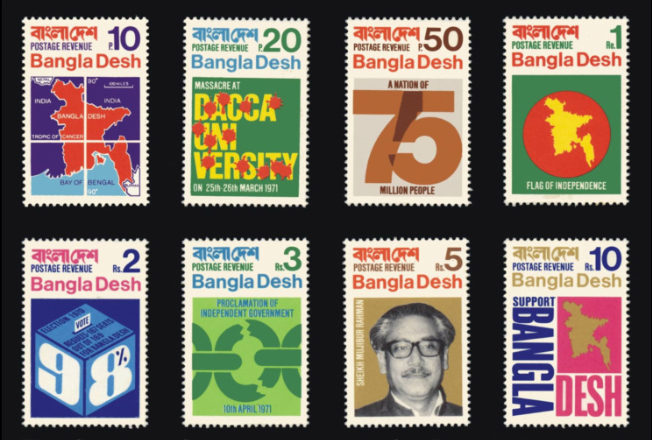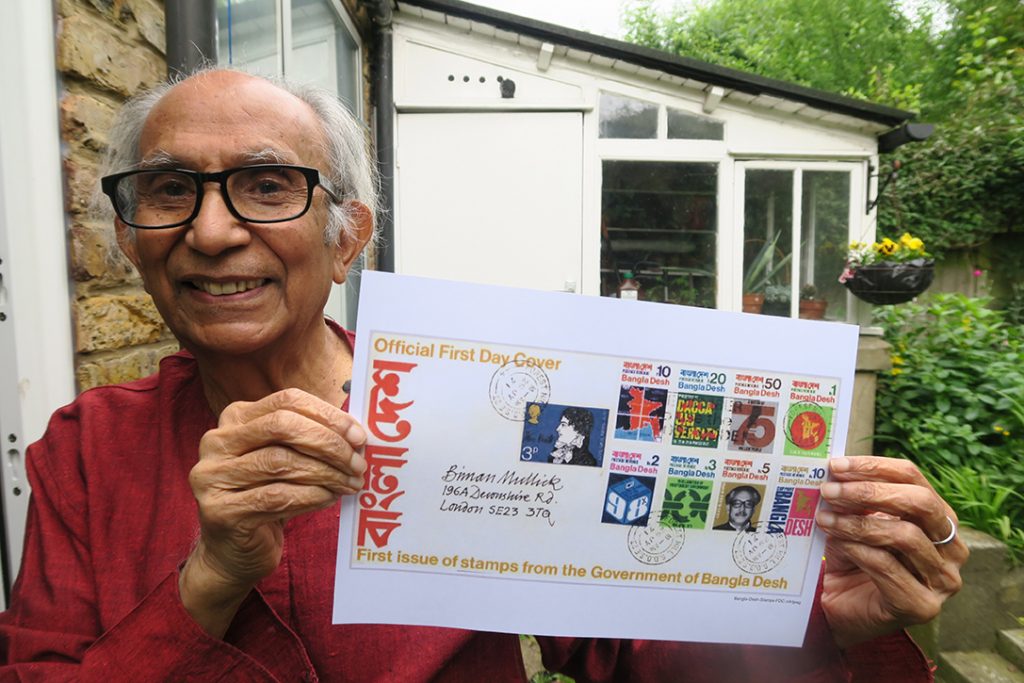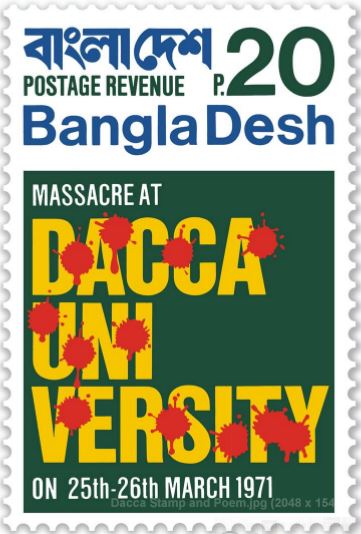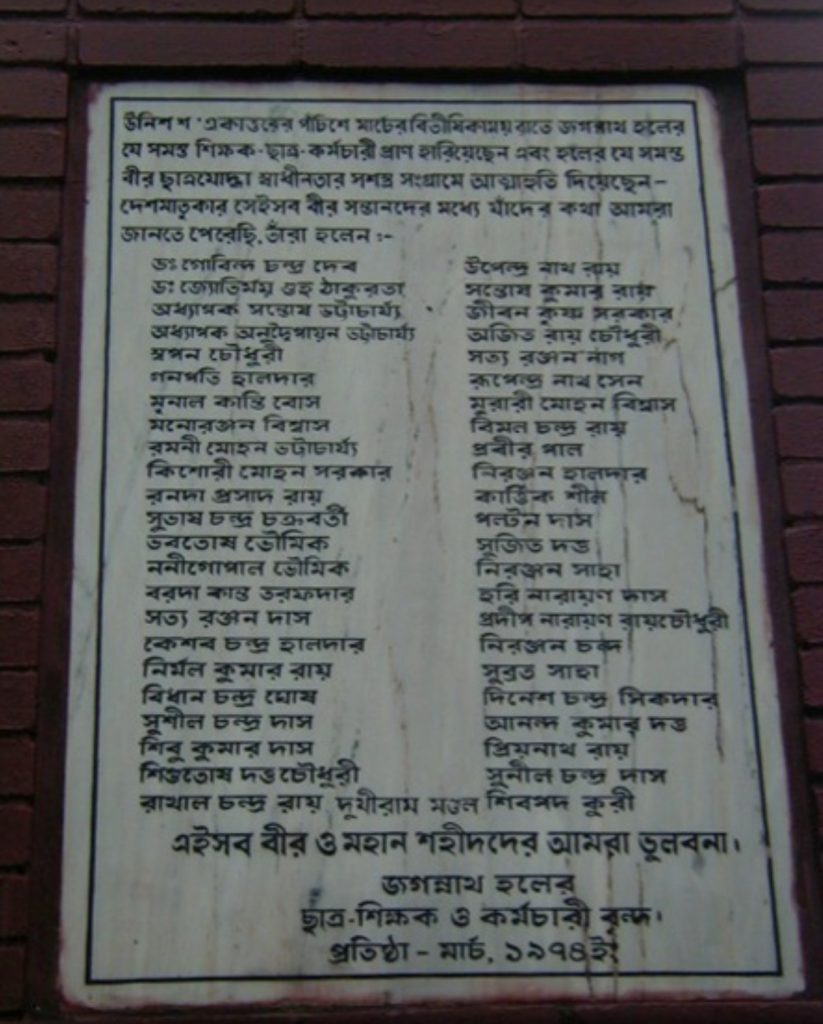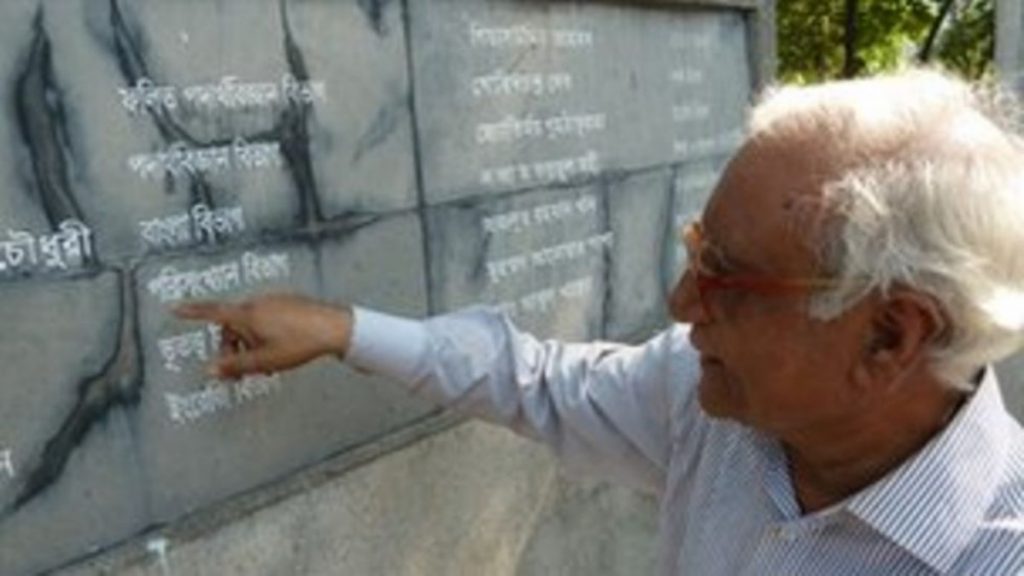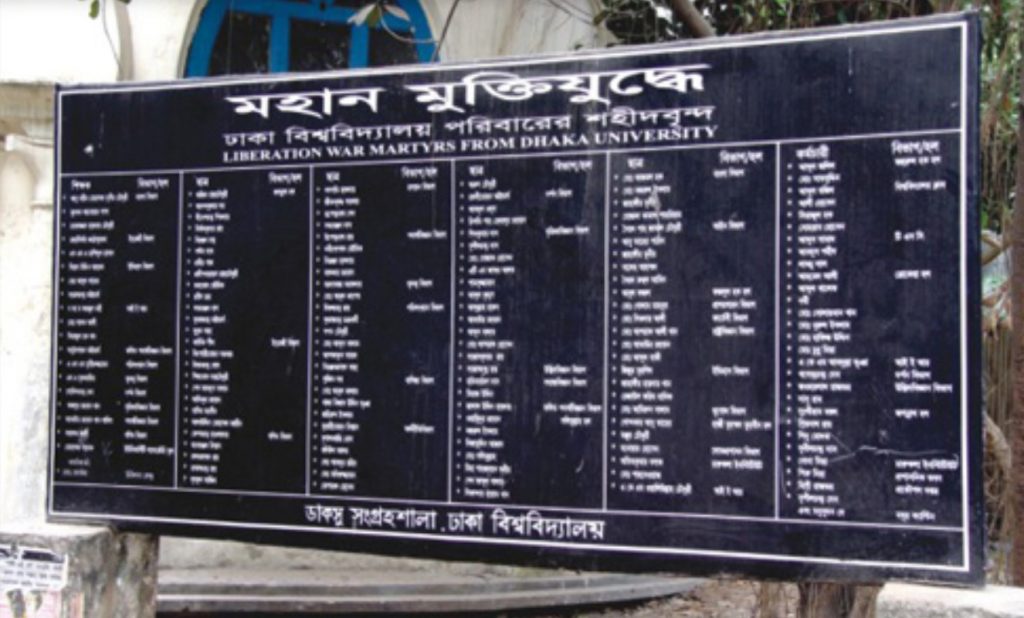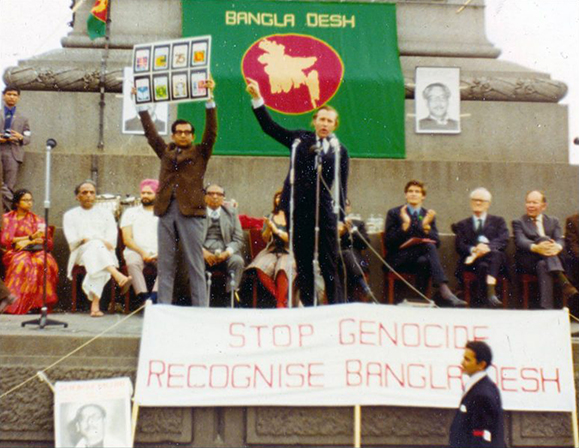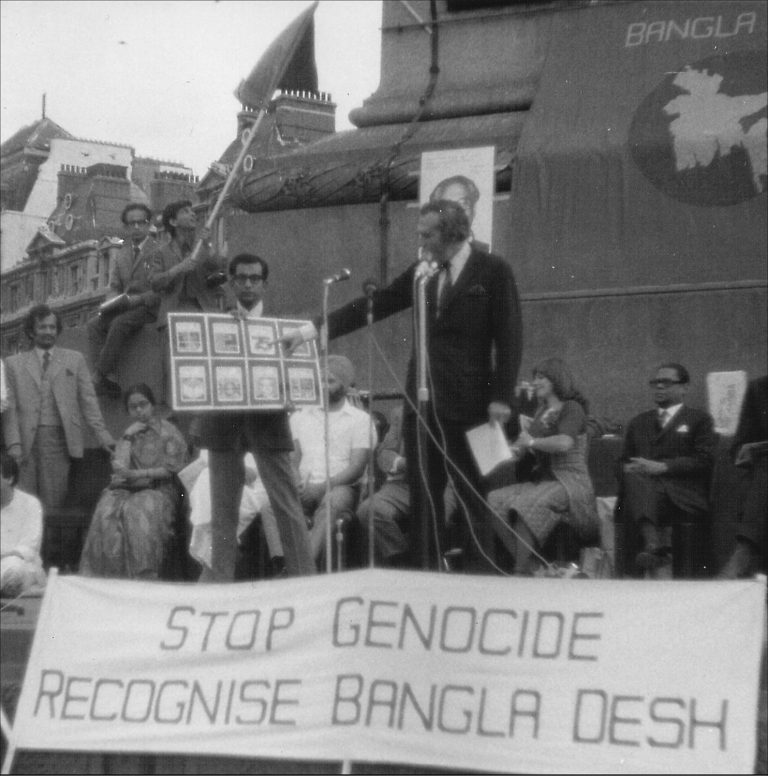The First Eight Stamps of Bangla Desh
Table of Contents
Click Here to View ContentsIntroduction
It is rare that we have an opportunity to come to know the person responsible for creating the postage stamps that a new nation first issues. Nevertheless, that is exactly the case here. In 1971 Mr. Biman Mullick, a Bengali from Howrah, India, found himself greatly disturbed by the civil war that was raging in Pakistan.
The war’s origins began with the partition of India in 1947 when Pakistan was created. Pakistan was divided into West Pakistan (today’s Pakistan) and East Pakistan (today’s Bangladesh). These two parts of Pakistan were separated by a distance of 2,200 km or about 1,350 miles. Cultural, economic, and language differences ultimately overwhelmed the unity of these two areas.
Following an election in 1971 in which the Awami League of East Pakistan, led by Sheikh Mujibur Rahman, won a majority of seats in the National Assembly of Pakistan civil war between East Pakistan and West Pakistan ensued. It was during this civil war that Biman Mullick was approached by British M.P. John Stonehouse and asked to create the first eight stamps of Bangladesh. This web page celebrates Biman Mullick’s work.
The Designs
Click the boxes below to view each stamp.
NOTE: The descriptions for each stamp were taken from the official 1971 Action PR press release which you can find in the Various Documents section of this page below.
#1 - Map of Bangladesh (10 paisa)
#2 - Massacre at Dacca University (20 paisa)
Yellow, scarlet, dark green, blue. Massacre at Dacca University on 25th-26th March 1971
Interview with Biman, Part 2
#3 - A Nation of 75 Million (50 paisa)
Orange, light brown, dark brown, grey. Bearing the number 75, denoting a new nation of 75 million people.
Interview with Biman, Part 3
#4 - Flag of Independence (₨. 1)
Yellow, scarlet, green. The Flag of Independence, incorporating map of Bangla Desh.
Interview with Biman, Part 4
#5 - Election of 1970 (₨. 2)
Blue, dark blue, magenta. Election 1970. Shows a ballot paper and stylized ballot box inscribed “Results – 167 Seats out of 169 for Bangladesh.” On side of box is highlighted 98%.
Interview with Biman, Part 5
#6 - Proclamation of Independent Government (₨. 3)
Green, dark green, blue. Depicting the breaking of links with West Pakistan and and Proclamation of Independent Government on 10th April 1971.
Interview with Biman, Part 6
#7 - Sheikh Mujibur Rahman (₨. 5)
Assimilated gold, orange, dark brown, half-tone black. Portrait of Sheikh Mujibur Rahman, leader of Bangla Desh.
Interview with Biman, Part 7
#8 - Support Bangla Desh (₨. 10)
The Sketchbook – The Beginning of Bangladesh Philately
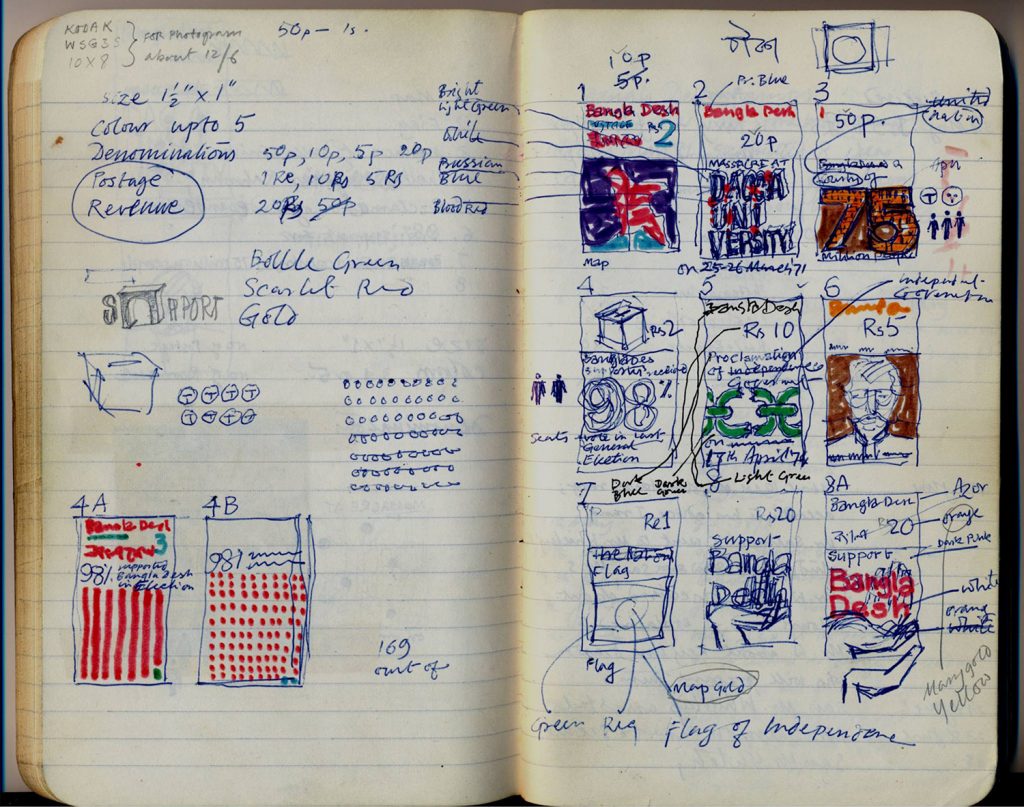
Two Pages from Biman Mullick’s sketch book. Pages show his very first ideas for the first set of postage stamps for Bangladesh (1971)
On April 29, 1971 Biman received a call from Member of Parliament Mr. John Stonehouse who asked him to design the first stamps of Bangladesh. He began his sketches the next day, April 30th, as he rode the train back and forth between his two positions at the Folkstone School of Art in Kent and the Harlow Technical College in Essex. On May 3rd Biman met Mr. Stonehouse for the first time and between May 3rd and May 12th he met with Mr. Stonehouse and Justice Choudhury. He presented the drafts of his stamps on May 12. On May 19th the drafts were submitted to Mr. Tajuddin Ahmed, the prime minister of Bangladesh. They were approved and returned to Biman as “Camera Ready.” Biman then met with two directors of Format International Printers, the company selected to print the stamps, on June 11. On June 30th Biman approved the proofs of the stamps and on July 26 the stamps were shown to international media. On July 29, 1971, they were published.
This all began with the sketchbook you see above.
Interview with Biman, Part 9: Sketchbook
The First Day Cover
For the First Day Cover, an additional British postage stamp was included in honour of poet John Keats. The first four Bangladeshi designs were franked by an automatic machine while the other four, as well as the Keats stamp, were franked by hand.
“I received this set of stamps along with the FDC on 26th July 1971 at a press conference held at the Harcourt room of Houses of Parliament, London where the stamps were shown to the representatives of the International news-media.
On 29th July 1971, on my way to the issuing ceremony which took place at a different room in the Houses of Parliament, I posted this FDC at my local post box at 10 a.m.,”
The FDC also had a British postage stamp issued in honor of poet John Keats. That stamp made it legal to mail the FDC in the United Kingdom. Biman also added all eight newly created Bangladesh stamps which, of course, are not valid for U.K. postage. It can be seen that the top set of four Bangladesh stamps were cancelled by machine while the U.K. stamp and the bottom four Bangladesh stamps were cancelled by hand. At the issuing ceremony Biman requested the attending audience to follow this example and use Bangladesh stamps as well as the required U.K. postage when sending any letter to their friends and relatives here in the U.K. or abroad. That action would not only raise valuable funds for the liberation movement of Bangladesh but would also help to publicize the freedom movement.
Interview with Biman, Part 10: First Day Cover
Dacca University Massacre
On March 7, 1971, Sheikh Mujibur Rahman announced the independence of Bangladesh from Pakistan. 18 days later West Pakistan commenced the military operation named “Operation Searchlight.” This comprehensive operation included an attack on Dhaka University in which professors and students were killed.
We Have Never Forgotten by Biman Mullick: It is 1971. The tyranny of the Pakistani government on Bangladesh continues. Inhuman tortures occur unabated. We are reading the news in the newspapers in London. We are also watching the news on television. Cries of agitation begin in our minds. We are feeling helpless. This injustice should be stopped. We want to protest against it.
One day we get the news that, the brutal Pakistani soldiers raided the hostels of Dhaka University on 25th and 26th March. They butchered the unarmed, innocent and sleeping students in the darkness of night. This incident hurt me very deeply. It took away my sleep. It disturbed all my thoughts. At that time I was teaching as a guest professor at Harlow Technical College & Folkstone School of Art. Suddenly, it seemed that the faces of my students appeared in front of my eyes. I thought, “What if any brutal force obliterates them from the surface of earth in the middle of the night?”
I did not need to wait for the inspiration when I got the responsibility to design the first postage stamps of Bangladesh. I was already charged mentally. That charge was the source of inspiration.
This incident of massacre ignited my inspiration. That inspiration gave birth to the composition of one of the eight postage stamps. That stamp is my most favorite among those eight stamps.
Needless to say, the designing of the first set of postage stamps for Bangladesh is the most significant work in my career as an artist.
That incident remains fresh in my mind even today. I think I shall not be able to forget that incident ever. A few years ago, I wrote a poem focusing on that massacre.
Blood on a Postage Stamp
The tyrant, the bully, hit the country’s heart with a bullet.
Writers and poets used their pens.
I had a paint brush in my hand.
The task was very difficult.
As a solution I splashed blood on a stamp.
The tyrant, the bully hit the country’s heart with a bullet.
By protesting my paint brush became honored.
The Press Conference, The Auction, and the Trafalgar Square Rally
A press conference was held on July 26, 1971. As part of the press conference there was a general question and answer session attended by members of the international press.
Mr. Biman Mullick’s stamps were exhibited and several dignitaries, including Member of Parliament, Mr. John Stonehouse, were present. All photos were taken by Aparajita Mullick.
On July 26, 1971, in the Harcourt Room in the Houses of Parliament, in front of a group of journalists representing various newspapers from around the world, the announcement was made that the first eight stamps of Bangladesh were being released. The Harcourt Room overlooked the river Thames.
On July 29, 1971, the stamps were released in House of Parliament Room #8. The presentation was attended by many Bangladeshis. Mr. Mullick then explained the significance of the stamps and how they legitimized the status of Bangladesh as a full-fledged country. After his explanation an auction was held and the first set of stamps sold for £230 to a Bangladeshi businessman. The second set was purchased by another Bangladeshi for £200. Both sets were autographed by Mr. Biman Mullick, Mr. Stonehouse, and Justice Chowdhury.
There was one Indian journalist present. His name was Mr. Sundar Kabadi from a daily newspaper called, “Amrita Bazar Patrika.” In due course the news of this event was reported.
Mr. Stonehouse’s Bangladesh Relief Committee received over £1000 through the sale of stamps that day. Biman’s comments to the audience are shown below.
My dear friends and citizens of independent Bangladesh,
First of all let me thank you for giving me the opportunity to design the first set of stamps for the independent Bangla Desh, which has great historic value. In this set of stamps I tried to combine two objects, one is to provide with the basic facts about Bangla Desh and the other is to show that Bangla Desh is a modern forward looking friendly country with a bright future. The whole range of stamps gives a flavor of optimism.
On the first ten paisa stamp I have shown the exact geographic location of Bangla Desh on the world map with extra emphasis on the 90 degree longitude and the Tropic of Cancer. That also confirms that Bangla Desh is not just an imagination, it is a reality.
The second stamp gives a graphic interpretation of one of the greatest calamity in the History of mankind – The massacre at Dacca University on 25th and 26th March this year, committed by military government of Pakistan.
The 50 paisa stamp shows the population of Bangla Desh. So the outsider can compare with their own population and realise that the problem of Bangla Desh is a problem of an independent nation of 75 million people.
One rupee stamp shows the flag of the independent government of Bangla Desh.
Two Rupee stamp shows the recent election results on a formalized ballot box with the emphasis on the support for Bangla Desh of the 98% of the total population.
Three Rupees stamp summarizes the complete development. It shows two objects. The broken chain symbolizes the breakdown of 25 years immoral and unethical Pakistani domination of Bangla Desh. It also shows the broken link with the illegal immoral regime.
Without the mention of the great Leader Sheikh Mujibur Rahman, the set would be incomplete. I have shown my respect to the great man on 5 Rupees stamp. He is not only the leader of Bangla Desh but also he is one of the greatest leaders of Asia.
The last but not the least is the 10 Rupees stamp which I have specially designed for the supporters of Bangla Desh.
Now let me conclude with a small request. Please buy Bangla Desh Postage stamps and show your support and solidarity. When you write a letter to your friends here in England and Overseas please fix at least one Bangla Desh postage stamp in addition to the usual postage; that would cost you very little. I hope you all know that the ten paisa stamp only costs you half a new pence. I am sure all of you agree with me that this is too little to pay for a great cause.
Thank you. Joy Bangla.
Trafalgar Square. London. 1st August 1971. Photo: Dilip Pal.
The Overprints
On December 16, 1971, Pakistan surrendered and the civil war ended. A member of British Parliament, John Stonehouse, asked Biman Mullick to design an overprint for the 8 stamps he had designed. After much thought Biman decided on the phrase “Bangladesh Liberated.” These stamps, released on December 20, 1971, are known as “the overprints.” A more complete story is included below.
17th December 1971. The day was my birthday. It was early in the morning. The telephone rang. What a botheration! Who is ringing at this ungodly hour? Mr. Stonehouse was on the other end of the phone. “Did you know that yesterday the Pakistani Army surrendered under Jagjit Singh Aurora, the joint commander of the Indian and Bangladesh Liberation Army?” he asked.I was waiting for this news. What a relief!
It was the best birthday present I ever had.
Mr. Stonehouse also said, “This incident should be celebrated through stamps. So, I want to publish 3 stamps overprinted with ‘BANGLADESH LIBERATED’.”
He did not specify which 3 out of the 8 stamps I designed were to be overprinted. He asked me to choose.
The first set of 8 postage stamps of Bangladesh was released on 29th July, 1971. It was five to six months before this, though, that the independence of Bangladesh had been declared on 10th April, 1971 from the ever-moving seat of government known as Mujibnagar. But, still, the world did not recognize Bangladesh as being an independent country. The Pakistani soldiers were still imposing their tyranny on the people of Bangladesh.
I was upset from March to December that year. My happiness knew no bounds after I received the news. How could I express my happiness in words?
Besides that, there was a personal reason for my happiness. There were many people who used to call the stamps of Bangladesh ‘labels’ or ‘stickers’ and did not recognize them as stamps. Those people would now be obliged to properly call the stamps ‘Stamps.’
Mr. Stonehouse suggested that I use the phrase, “BANGLADESH LIBERATED.” I suggested to him that we include the phrase in Bengali as well as in English. He agreed and said, “Of course! You should do the translation of this.”
I rang him again and explained, there were three possible ways of expressing “BANGLADESH LIBERATED” in Bengali.
‘Bangladesh Liberated’, বাংলাদেশ মুক্ত (Bangladesh Mukta)
‘Liberated Bangladesh’, মুক্ত বাংলাদেশ (Mukta Bangladesh)
or
‘The Liberation of Bangladesh.’ বাংলাদেশের মুক্তি (Bangladesher Mukti)
“Which one shall I write?”, I asked.
He replied, “I do not know the Bengali language. You should decide this yourself. Moreover, it will take a long time if we want to discuss it with the cabinet. The momentum won’t be the same.”বাংলাদেশ মুক্ত ! মুক্ত বাংলাদেশ !! বাংলাদেশের মুক্তি !!!
Which one was the best choice? A dilemma arose in my mind regarding this.
Like every other issue, I discussed it with my wife, Aparajita. Aparajita’s reply was, “All three of them are correct. Any of these can be used.”
I chose the Bengali phrase, বাংলাদেশের মুক্তি (Bangladesher Mukti), which literally means “THE LIBERATION OF BANGLADESH,” as it conveyed a more heartfelt sentiment in the Bengali language.
Once again, I sought Aparajita’s opinion and she agreed with my decision.
For the English phrase, naturally I decided to use “BANGLADESH LIBERATED” as suggested by Mr. Stonehouse.
I decided that the phrases were to be overprinted on the already printed stamps that had values of Rs.10, Rs.5, and P.10. On the examples I sent to Mr. Stonehouse I showed the exact place where the overprint was to be placed as each of these three stamps was completely different. Of course, this decision required careful consideration as overprinted text was not part of my original designs. I also specified the exact size of the type. Then I sent the layout to Mr. Stonehouse. At the same time, I called him and told him, “Here in London it is not possible to print using Bengali typeface (font) as Format Printers does not have Bengali type. So, the Bengali wording, Bangladesher Mukti, বাংলাদেশের মুক্তি has to be drawn by a good lettering artist.”
He replied with a monosyllabic sound, “Hmm.”
Three days later, on 20th December, 1971 as planned, the 3 stamps were published with the overprint. But the words, বাংলাদেশের মুক্তি, were not drawn by a lettering artist as I had suggested. Instead, my handwritten Bengali characters were used. At first, I was a little bit unhappy as I was concerned that the result would not be as professional as I wanted. Then I thought to myself that this was an urgent situation. Maybe it was appropriate under these circumstances.
Much later, I discovered that many forged stamps of different denominations were overprinted at different times. I don’t know who the forgers were. I was irritated about that. I was also hurt because an artist treasures his or her creations and it is highly disrespectful for someone to alter or mutilate these works in any way.
How long can one carry this irritation? It is peaceful to forget those things now. Joy Bangla.
Essays
“The First Eight Stamps of Bangladesh” by Abdul Matin
Abdul Matin gives a detailed account of the creation of the first eight stamps of Bangla Desh. Continue Reading →
Extract from “Prabase Muktijuddher Dinguli” by Abu Sayeed Chowdhury
The introduction to Justice Chowdhury’s autobiography. It gives a brief overview of the events leading up to the first eight stamps of Bangla Desh. Continue Reading →
26th March — A Night of Blood
Biman Mullick recalls the Dhaka University Massacre, learning of the Pakistani surrender, and being asked to design Bangla Desh’s first eight stamps. Continue Reading →
Various Documents
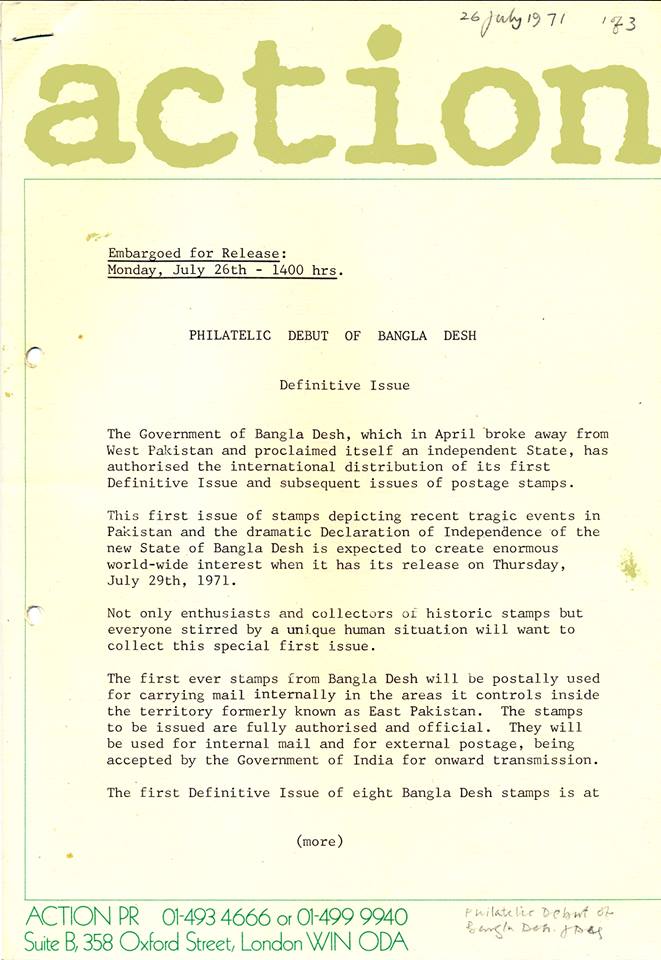
DOCUMENT: Press Release (26 July 1971)
Embargoed for Release:Monday, July 26th – 1400 hrs. PHILATELIC DEBUT OF BANGLA DESH Definitive Issue The Government of Bangla Desh, which in April broke away from West Pakistan and proclaimed
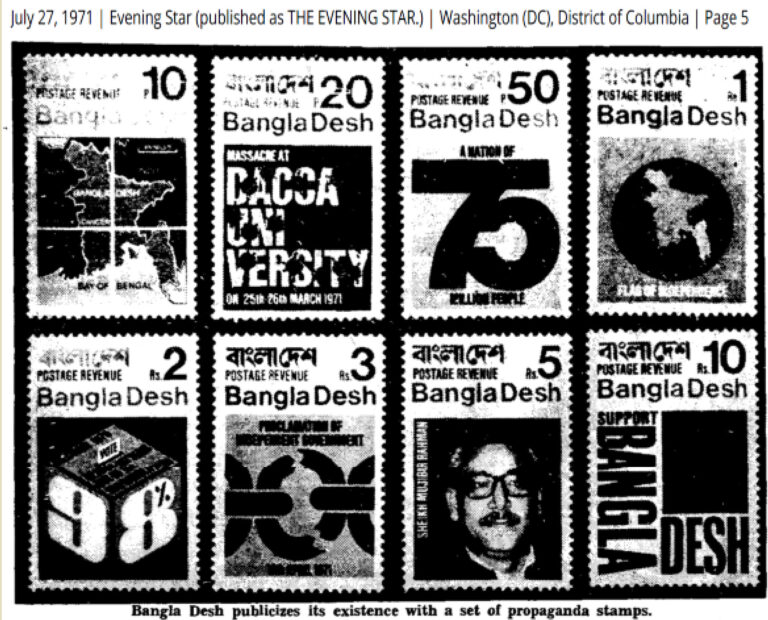
Article: The Evening Star (27 July 1971)
In the July 27, 1971 issue of “The Washington Evening Star”, a newspaper published in Washington D.C. from 1852 to 1981, Biman’s stamps were highlighted in a graphic shown above. Continue Reading →
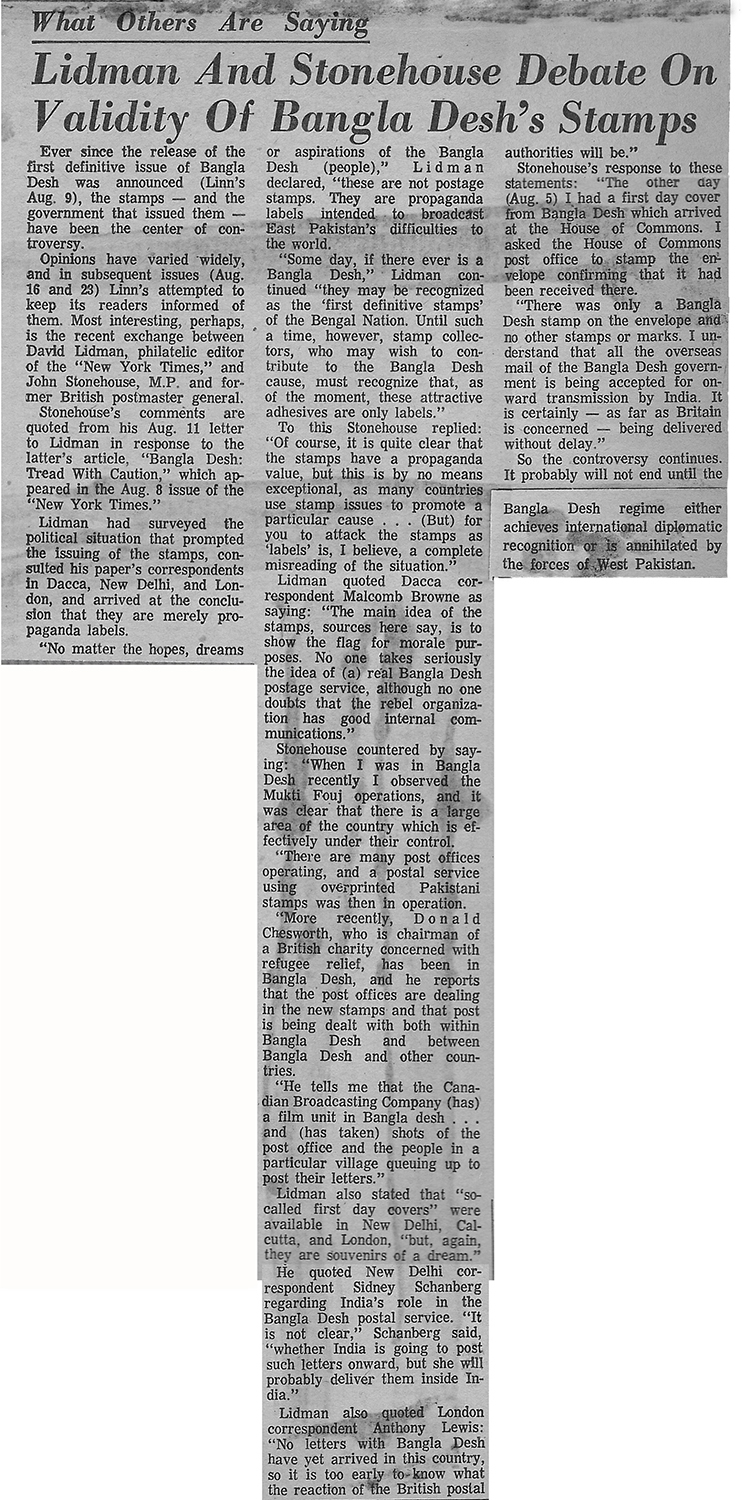
ARTICLE: Linn’s Stamp News (20 Sept. 1971)
Lidman and Stonehouse Debate On Validity of Bangla Desh’s Stamps Ever since the release of the first definitive issue of Bangla Desh was announced (Linn’s Aug. 9), the stamps —
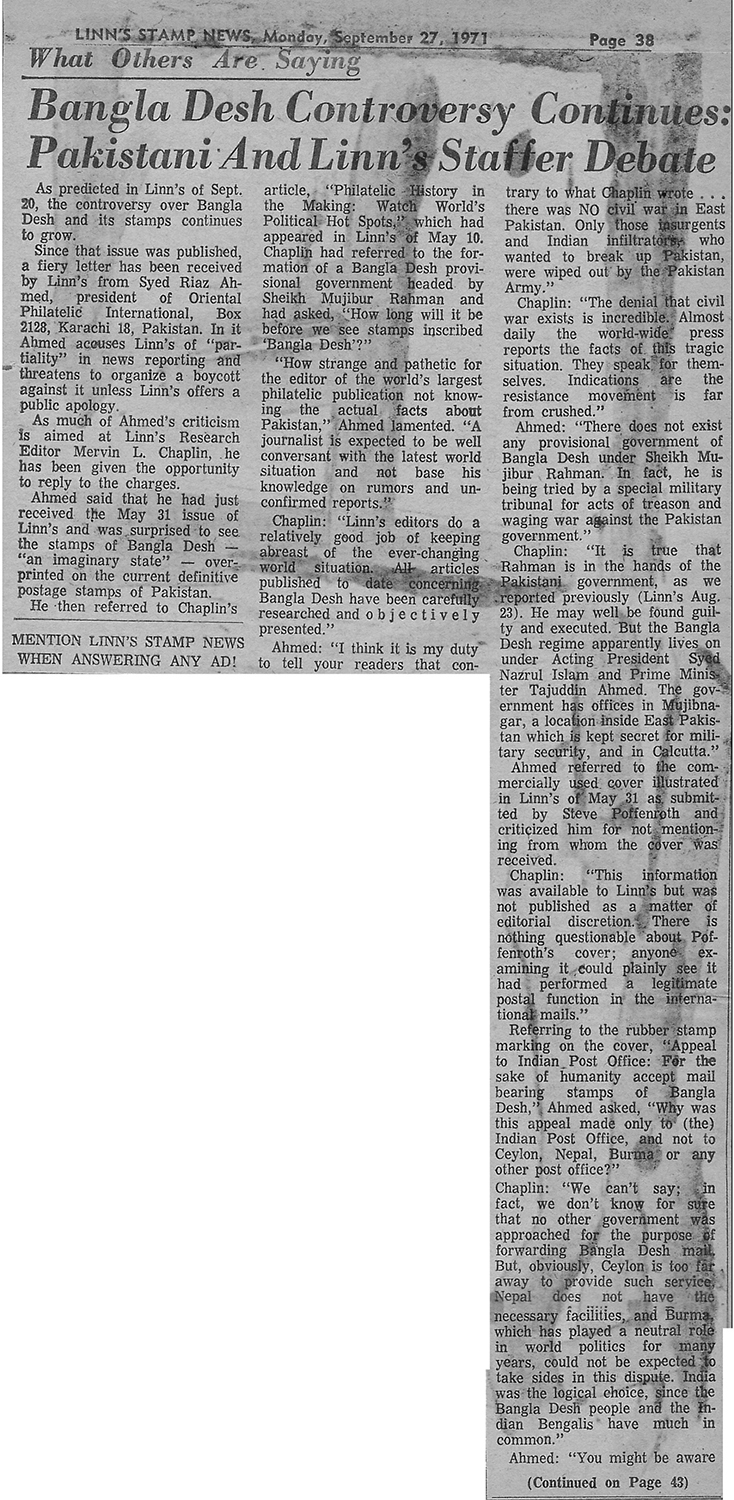
ARTICLE: Linn’s Stamp News (27 Sept. 1971)
ARTICLE: Linn’s Stamp News (27 Sept. 1971) Bangla Desh Controversy Continues: Pakistani and Linn’s Staffer Debate As predicted in Linn’s of Sept. 20, the controversy over Bangla Desh and its
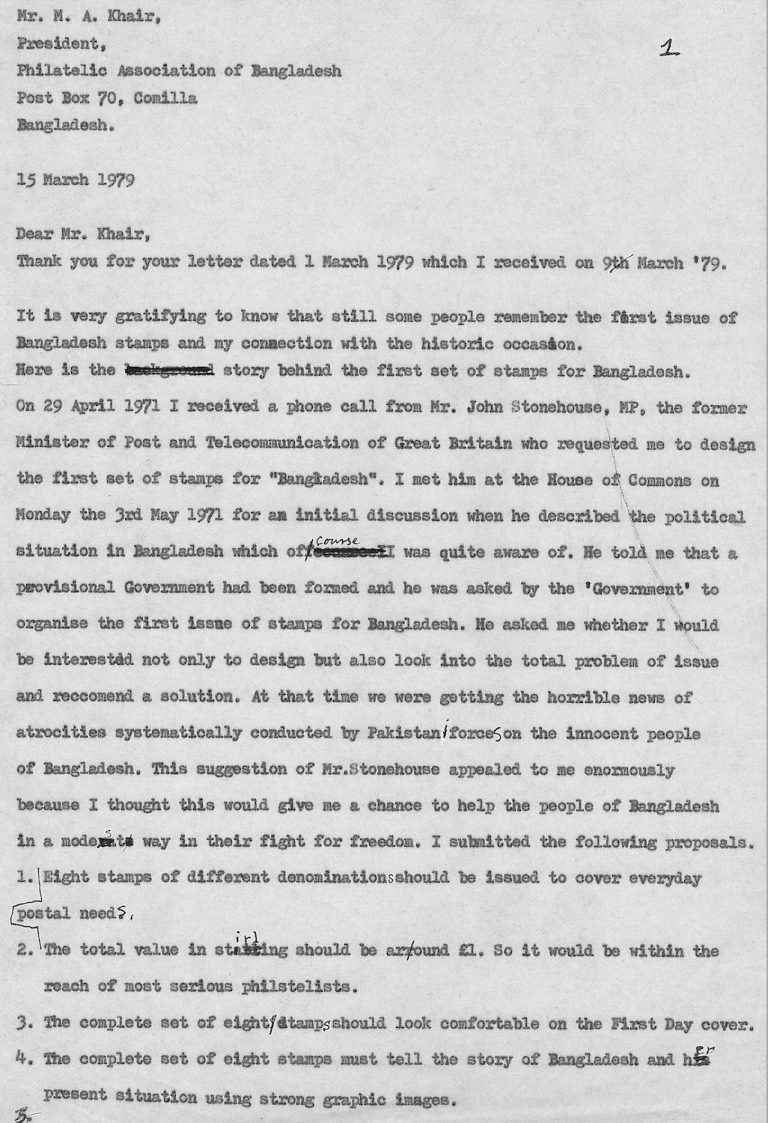
LETTER: Biman and the Philatelic Association of Bangladesh (1979)
A letter to the Philatelic Association of Bangladesh written by Biman Mullick highlighting how he was selected to design the first eight stamps of Bangladesh. Continue Reading →
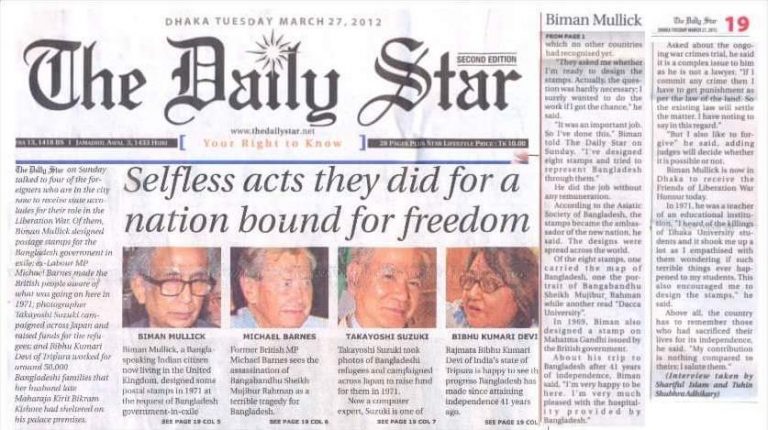
ARTICLE: Daily Star (27 Mar. 2012)
BIMAN MULLICK Biman Mullick, a Bangla-speaking Indian citizen now living in the United Kingdom, designed some postal stamps in 1971 at the request of the Bangladesh government-in-exile which no other

